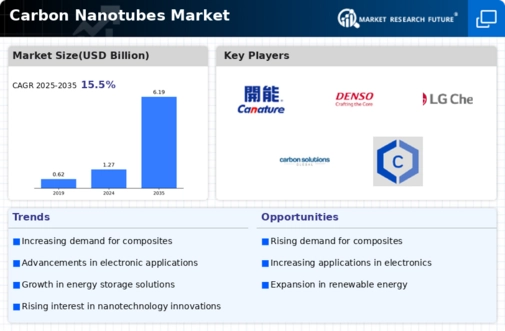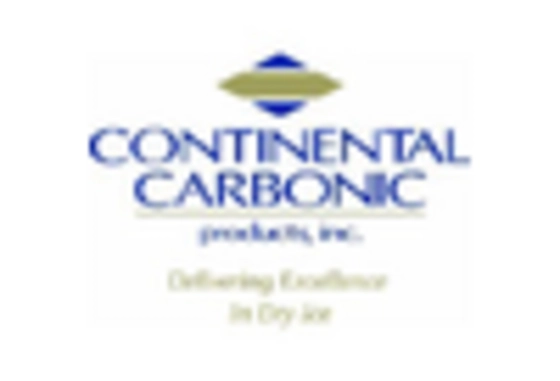Growth in Automotive Sector
The Carbon Nanotubes Market is poised for growth as the automotive sector increasingly incorporates advanced materials to enhance vehicle performance. Carbon nanotubes are utilized in various applications, including lightweight composites and conductive materials for electric vehicles. The automotive industry is undergoing a transformation towards electric mobility, with projections indicating that electric vehicle sales could reach 30 percent of total vehicle sales by 2030. This shift is likely to create substantial opportunities for carbon nanotubes, as they can improve battery efficiency and reduce overall vehicle weight. Consequently, the demand for carbon nanotubes in automotive applications is expected to rise, reflecting a broader trend towards innovation and sustainability in transportation.
Rising Demand in Electronics
The Carbon Nanotubes Market is significantly influenced by the rising demand for advanced electronic components. Carbon nanotubes are being explored for their potential in various electronic applications, including transistors, sensors, and displays. Their unique electrical properties allow for the development of smaller, faster, and more efficient electronic devices. The Carbon Nanotubes is projected to grow at a compound annual growth rate of over 5 percent, which may further stimulate the demand for carbon nanotubes. As manufacturers seek to enhance the performance and miniaturization of electronic devices, the integration of carbon nanotubes is likely to become more prevalent, thereby driving growth in the carbon nanotubes market.
Focus on Sustainable Manufacturing
The Carbon Nanotubes Market is increasingly aligned with the focus on sustainable manufacturing practices. As industries strive to reduce their environmental impact, the demand for materials that contribute to sustainability is rising. Carbon nanotubes, known for their strength and lightweight properties, can lead to reduced material usage and lower energy consumption in manufacturing processes. The global push towards sustainability is reflected in various sectors, including construction, automotive, and electronics, where carbon nanotubes are being integrated to enhance product performance while minimizing environmental footprints. This trend is likely to drive the adoption of carbon nanotubes, positioning them as a key material in the transition towards more sustainable manufacturing practices.
Increasing Applications in Aerospace
The Carbon Nanotubes Market is experiencing a surge in demand due to the increasing applications of carbon nanotubes in the aerospace sector. These materials are recognized for their lightweight and high-strength properties, which are essential for enhancing the performance of aircraft. The integration of carbon nanotubes in composite materials can lead to weight reductions of up to 30 percent, thereby improving fuel efficiency. As aerospace manufacturers seek to innovate and reduce operational costs, the adoption of carbon nanotubes is likely to expand. Furthermore, The Carbon Nanotubes is projected to grow significantly, which may further drive the demand for advanced materials like carbon nanotubes, positioning them as a critical component in future aerospace designs.
Advancements in Energy Storage Technologies
The Carbon Nanotubes Market is benefiting from advancements in energy storage technologies, particularly in batteries and supercapacitors. Carbon nanotubes are being utilized to enhance the performance of these energy storage devices, offering improved conductivity and energy density. The Carbon Nanotubes is expected to witness substantial growth, with projections indicating a market size exceeding 500 billion dollars by 2030. This growth is likely to be fueled by the increasing demand for renewable energy sources and the need for efficient energy storage solutions. As energy storage technologies evolve, the role of carbon nanotubes in enhancing performance and efficiency is expected to expand, thereby driving demand within the carbon nanotubes market.

















Leave a Comment